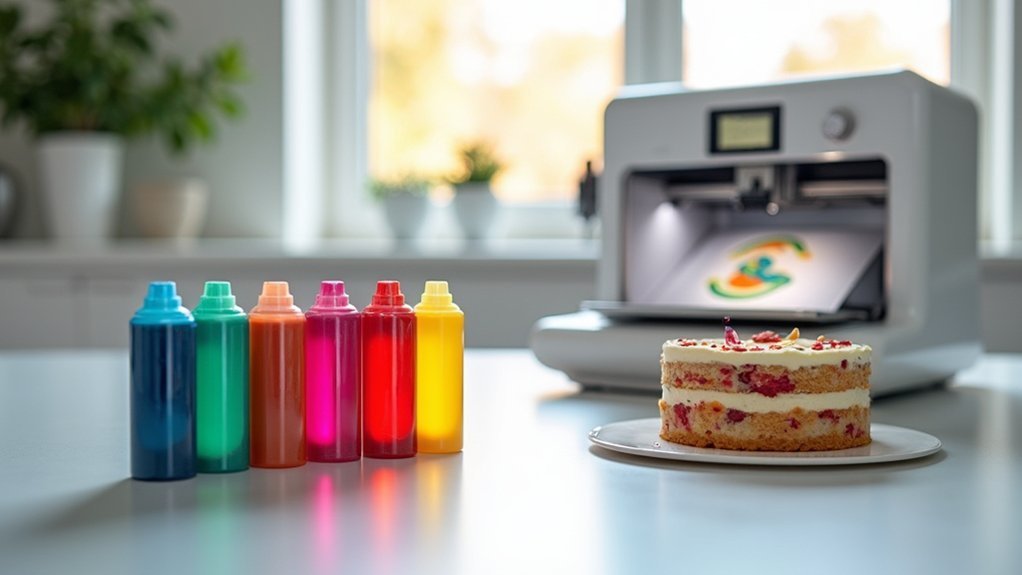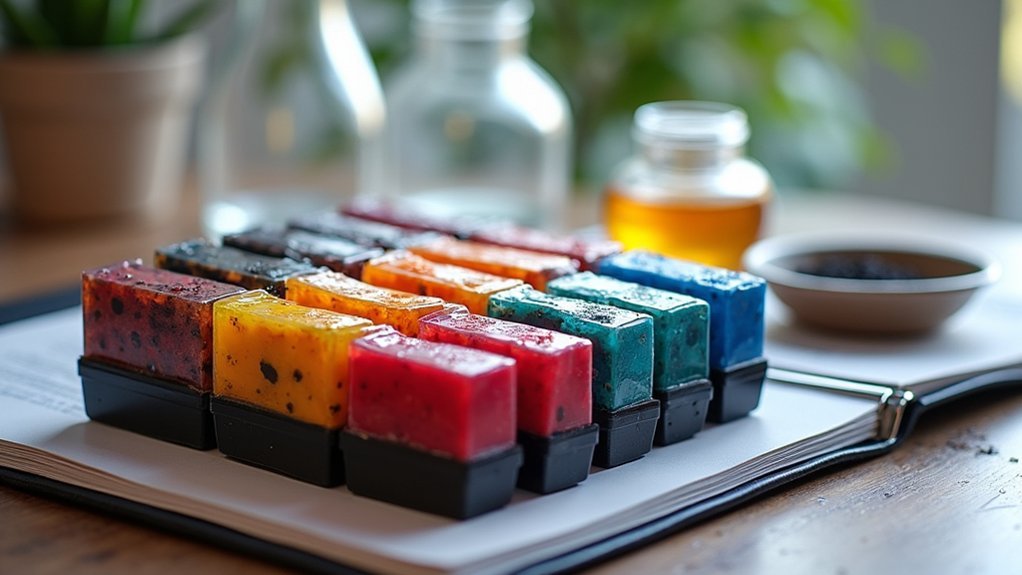You can now print directly onto cookies, cakes, and candies using FDA-approved edible ink cartridges that contain food-grade dyes, gelatin, and cornstarch instead of traditional toxic printing materials. These revolutionary cartridges enable you to create personalized treats at premium prices, with customized cookies commanding $3.00-$5.00 each while costing only $0.06 in ink for three cookies. The technology supports both natural colorants from sources like beet juice and synthetic options for superior brightness, all while meeting stringent safety standards for direct food contact. Advanced 4D printing innovations promise even more transformative culinary experiences ahead.
Understanding Edible Ink Composition and Safety Standards

When you’re exploring edible ink technology, you’ll discover that these specialized cartridges contain carefully formulated food-grade materials designed to meet strict safety standards.
You’ll find that edible inks primarily consist of FDA-approved food dyes, binders like gelatin and cornstarch, plus environmentally friendly solvents such as glycerol and water.
Manufacturers guarantee you’re getting allergen-free products compatible with dietary restrictions, including vegan and gluten-free options.
You’ll benefit from compliance with international food safety regulations, as these inks must be certified safe for consumption.
The formulations include antimicrobial agents that extend shelf life and reduce foodborne illness risks.
You’ll also appreciate ongoing research focusing on eco-friendly binders and natural alternatives supporting sustainable food production practices.
Natural Vs Synthetic Colorants in Food Printing Applications
As you consider colorant options for edible ink applications, you’ll face a fundamental choice between natural and synthetic alternatives that considerably impacts your final product’s appearance, safety profile, and consumer appeal.
Natural colorants derived from beet juice, turmeric, and spirulina offer significant advantages for health-conscious consumers.
You’ll benefit from:
- Antioxidant properties that add nutritional value to your printed foods
- Consumer perception of safety and clean labeling
- Dietary compliance with vegan and allergen-free requirements
However, synthetic colorants provide superior performance characteristics.
They’re engineered for enhanced stability, brightness, and consistent color reproduction across batches.
While both options must meet regulatory safety standards, you’ll find that natural colorants align better with current market trends favoring healthier, plant-based ingredients despite potential color variation challenges.
Essential Binders and Additives for Print Quality Enhancement

Beyond selecting the right colorants, you’ll need to master the art of binder and additive selection to achieve professional-quality edible prints.
Essential binders like gelatin, cornstarch, and gum Arabic hold your ink ingredients together while ensuring proper adhesion to food surfaces. These components directly impact viscosity, which is crucial for effective printing processes.
You’ll want to incorporate additives like glycerol and propylene glycol to enhance your ink’s performance. Glycerol offers an environmentally friendly option that meets consumer demands for sustainable products.
Consider natural alternatives like eco-friendly binders derived from potato flakes for healthier formulations.
The rheological properties of your edible ink technology, particularly shear thinning behavior, are crucial. This allows ink to flow smoothly through printers while maintaining structural integrity on food items.
Extraction Methods for Plant-Based Edible Colorants
While your binder and additive selections lay the foundation for quality edible inks, the colorants themselves require careful extraction from plant sources to enhance their potential.
Successfully obtaining plant-based edible colorants depends on choosing the right extraction technique for your specific application needs.
The extraction technique you select will determine the success of your plant-based edible colorant project from start to finish.
Three primary methods dominate the extraction landscape:
- Aqueous extraction – Uses water to preserve natural pigment properties while maintaining food safety standards.
- Ultrasonic extraction – Employs high-frequency sound waves to boost efficiency and reduce processing time considerably.
- Microwave-assisted extraction – Utilizes targeted energy heating for superior yields compared to traditional approaches.
Your extraction method choice directly affects color quality, yield, and stability.
Don’t overlook particle size reduction during processing—it’s essential for achieving fine dispersion that guarantees ideal printability and food appearance.
Rheological Properties and Antimicrobial Activity Assessment

Precision becomes paramount when evaluating how your edible inks will perform under real printing conditions. You’ll need to analyze the rheological properties, including viscosity and shear thinning behavior, to optimize printability and guarantee consistent application on food substrates.
Your ink’s functional performance depends greatly on ingredient combinations, making precise rheological analysis essential.
You can’t overlook antimicrobial activity assessment either. When you incorporate antimicrobial agents, you’re enhancing food safety by reducing foodborne illness risks while extending shelf life.
The disc diffusion method effectively tests your ink’s antimicrobial properties, ensuring human consumption safety and food safety compliance.
Continuous research into improving these rheological and antimicrobial properties remains essential as you address food printing challenges and enhance consumer safety.
Advanced Printing Technologies for Edible Materials
As you shift from analyzing ink properties to actual implementation, advanced printing technologies revolutionize how edible materials reach food surfaces with unprecedented precision.
You’ll find that edible ink printers utilize sophisticated inkjet and 3D printing methods that deliver remarkable aesthetic enhancement and personalization capabilities.
Modern edible ink printers leverage three key technological innovations:
- Cartridge compatibility systems that maintain ideal viscosity and printability for superior imaging quality
- Plant-based protein integration enabling dynamic shape and color transformations in 3D-printed foods
- Advanced extraction methods using ultrasonic and microwave-assisted techniques to enhance colorant quality
You’re also seeing antimicrobial agent integration that extends shelf life while maintaining food freshness throughout the printing process, ensuring both safety and quality in your final products.
3D Food Printing Capabilities and Plant Protein Inks
You’ll find that plant protein inks made from pea and soy create versatile semi-solid pastes and gels perfect for 3D and 4D food printing applications.
These innovative inks let you design foods that change shape over time while customizing nutritional profiles to match your specific dietary requirements.
You can now print intricate food structures with enhanced colors and textures that weren’t possible with traditional edible inks.
Plant Protein Ink Properties
When you’re exploring plant protein inks for food printing, you’ll discover they possess remarkable versatility in forming semi-solid pastes, gels, and emulsions that open up countless culinary possibilities.
These innovative inks transform how you approach food creation through advanced printing technologies.
The most effective plant protein inks demonstrate three key characteristics:
- Superior rheological properties – Pea and soy proteins create ideal flow and consistency for enhanced printability
- Structural adaptability – They form various textures from semi-solid pastes to stable gels and smooth emulsions
- Nutritional customization – You can control precise nutrient profiles while creating intricate food designs
You’ll find these inks perfectly align with health-conscious dietary preferences, supporting vegan and gluten-free requirements while enabling personalized nutrition delivery through sustainable food production methods.
4D Printing Shape Changes
Beyond static food creation, plant protein inks release the revolutionary potential of 4D food printing—where your printed foods actually transform their shape and color after printing. You’ll witness your meals evolve dynamically, creating unprecedented dining experiences that engage multiple senses simultaneously.
| Transform Type | Plant Protein Response | Food Printing Applications |
|---|---|---|
| Shape Change | Gel restructuring | Self-folding pasta, expanding bread |
| Color Shift | pH-sensitive reactions | Mood-responsive desserts, ripeness indicators |
| Texture Evolution | Protein crosslinking | Tenderizing steaks, crisping surfaces |
These protein-based inks respond to environmental triggers like temperature, moisture, and time. You’re not just eating food—you’re experiencing culinary theater where pea and soy proteins orchestrate controlled transformations. This technology enables personalized nutrition delivery, ensuring your dietary requirements are met through precisely timed releases.
Nutritional Customization Benefits
Since plant protein inks can be precisely formulated with specific nutrients, you’re able to create meals that match your exact dietary requirements down to the gram.
This nutritional customization transforms how you approach personalized nutrition.
You’ll benefit from three key advantages:
- Allergen-free options – Plant protein inks eliminate common allergens while maintaining complete nutritional profiles.
- Vegan compatibility – These inks cater to plant-based diets without compromising protein quality or taste.
- Controlled nutrient release – 4D printing technology allows you to design foods that release nutrients at ideal times for maximum absorption.
The semi-solid pastes and gels created from plant proteins don’t just print into intricate shapes—they’re engineered to deliver exactly what your body needs, when it needs it.
Commercial Applications Across Bakeries and Food Services
You’ll discover that edible ink cartridges transform your bakery’s profit potential by enabling premium-priced personalized treats that command $3.00 to $5.00 each compared to standard baked goods.
Your restaurant can now offer instant customization services, printing customer names, logos, or special messages directly onto desserts within seconds of ordering.
This technology positions your food service business to capture the lucrative personalization market while maintaining efficient production speeds and minimal ink costs.
Bakery Profit Maximization
When your bakery adopts edible ink printing technology, you’ll transform low-margin products into premium offerings that command considerably higher prices. Customized cookies utilizing edible ink in food applications sell for $3.00 to $5.00 each, dramatically increasing your profit margins compared to traditional frosting methods.
Your profit maximization strategy benefits from three key advantages:
- Reduced material costs – You’ll save money by eliminating frosting sheets, with ink costs averaging just $0.06 for three cookies.
- Increased production speed – Your team can produce 12 cookies in 2 minutes, maximizing efficiency while minimizing labor expenses.
- Immediate sale readiness – Printed items dry instantly, allowing you to respond quickly to customer demands without inventory delays.
This technology enables diversification across macarons and lollipops, attracting broader customer bases.
Restaurant Customization Services
As restaurants expand their dessert offerings beyond traditional fare, edible ink printing technology transforms ordinary confections into memorable branded experiences that distinguish your establishment from competitors.
You can elevate customer dining experiences by incorporating personalized logos, seasonal messages, or special occasion designs directly onto desserts.
The Eddie Edible Ink Printer’s ten-second printing capability guarantees quick turnaround times during peak service hours, while its carousel system handles up to 350 candies in minutes for large catering events.
With edible ink costs at just $0.06 per three cookies, you’ll maintain healthy profit margins while charging premium prices for customized treats.
GMP and NSF® certifications assure food safety compliance, protecting your restaurant’s reputation and safeguarding customer confidence in your innovative dessert presentations.
Direct Cookie and Confection Printing Systems
Direct cookie and confection printing systems have revolutionized how you can customize baked goods, eliminating the traditional need for frosting sheets or hand-decorating techniques.
Systems like Eddie let you print directly onto cookies, macarons, and lollipops with remarkable efficiency and precision.
You’ll appreciate the impressive speed and cost-effectiveness these systems provide:
- Lightning-fast printing – Complete one cookie in just 10 seconds or up to 12 cookies in 2 minutes
- Minimal operating costs – Edible ink expenses average only $0.06 per three cookies printed
- Commercial-grade safety – GMP and NSF® certified print heads and inks guarantee food safety compliance
Each tray accommodates 3 to 3.5-inch cookies, making these systems perfect for bakeries and caterers seeking profitable customization solutions.
Sustainability and Eco-Friendly Production Practices
While direct printing systems transform cookie customization, the edible ink industry is simultaneously embracing sustainability practices that’ll reduce your environmental footprint.
You’ll find manufacturers adopting biodegradable packaging for ink cartridges, greatly minimizing waste output. These sustainable practices extend to innovative formulations using natural binders from potato flake byproducts, replacing synthetic materials you’d typically encounter.
Your production processes now consume less water and energy, aligning with green food industry initiatives. Researchers are developing plant-based ingredients that deliver performance while maintaining eco-friendliness.
This shift addresses your growing demand for healthier, environmentally responsible food options. You’re benefiting from waste reduction strategies that don’t compromise quality.
The industry’s commitment to sustainability guarantees you can enjoy customized edible prints while supporting environmental conservation efforts.
Market Profitability and Consumer Demand Trends
Beyond environmental benefits, edible ink cartridge technology drives remarkable profitability for bakeries and food service businesses.
You’ll see immediate cost advantages when you eliminate frosting sheets and reduce production time to just 10 seconds per cookie. This efficiency translates into substantial profit margins.
The market demonstrates strong financial potential through:
- Cookie pricing flexibility – You can charge $0.35 to $1.50 wholesale, with retail prices reaching $3.00 to $5.00
- Production efficiency gains – You’ll produce 12 customized cookies in just 2 minutes
- Immediate sale capability – You eliminate drying time, maximizing turnover
Consumer demand continues growing as customers seek personalized food products for events, corporate branding, and themed celebrations.
Bakeries like Baking Betty’s report significant time and cost savings, proving edible ink technology’s economic viability.
Regulatory Compliance and Industry Certifications
You’ll need to guarantee your edible ink cartridges meet FDA safety standards before selling them commercially.
These regulations require that all ingredients are food-grade and safe for human consumption.
You must also obtain GMP certification, which demonstrates that your manufacturing processes follow strict quality control protocols recognized by the food industry.
FDA Safety Standards
Since edible ink cartridges come into direct contact with food, they must meet stringent FDA regulations that require all ingredients to be food-grade and safe for human consumption.
You’ll find that manufacturers can’t simply use regular printer inks – every component must undergo rigorous testing to guarantee it won’t harm anyone who eats the printed food.
When you’re selecting edible ink for your food printing needs, look for products that demonstrate:
- FDA-compliant ingredients that meet strict food-grade standards
- Good Manufacturing Practices (GMP) certification guaranteeing quality control throughout production
- Continuous safety monitoring that maintains color vibrancy while meeting international regulations
These standards protect your customers and guarantee your printed foods remain safe, vibrant, and compliant with health regulations.
GMP Certification Requirements
Good Manufacturing Practice (GMP) certification represents the gold standard for edible ink cartridge production, requiring manufacturers to maintain controlled environments that eliminate contamination risks throughout every stage of the manufacturing process.
When you’re selecting edible ink cartridges, you’ll want to verify GMP certification guarantees strict regulatory compliance with FDA standards. This certification mandates the use of food-grade dyes and materials while implementing rigorous quality control measures.
You’ll find that GMP-certified manufacturers undergo regular audits and maintain thorough documentation processes to verify safety benchmarks.
Companies like Primera Technology hold both GMP and NSF® certifications, demonstrating their commitment to producing safe food printing solutions. This certification enhances your consumer trust while facilitating international market access through compliance with global food safety regulations.
Emerging Innovations in 4D Food Printing Technology
While traditional food printing creates static shapes, 4D food printing technology transforms how you’ll experience meals by incorporating edible ink made from plant proteins like pea and soy that actively change over time.
These innovative cartridges create semi-solid pastes, gels, and emulsions that adapt their shape and texture after printing.
You’ll benefit from three key innovations:
- Personalized nutrition – Healthcare settings can customize meals to meet your specific dietary requirements and preferences.
- Sustainable production – Optimized ingredient use minimizes waste while creating intricate designs impossible with traditional methods.
- Interactive dining – Controlled release profiles enable foods that change color or shape responding to environmental stimuli.
Researchers focus on molecular, functional, and nutritional traits ensuring safety standards while enhancing your dining experience through dynamic food transformation.
Frequently Asked Questions
Can I Put Edible Ink in Any Printer?
You can’t put edible ink in any printer. You’ll need a dedicated edible ink printer that’s food-safe and GMP certified. Standard printers aren’t designed for food-grade materials and create contamination risks.
Is Edible Ink Just Food Coloring?
No, you can’t simply use food coloring as edible ink. Edible ink’s a specialized formulation with specific viscosity, binders, and additives designed for food printers, unlike basic food coloring which lacks proper consistency.
Can I Make My Own Edible Ink?
You can make your own edible ink by mixing food-grade colorants with binders like cornstarch and solvents like glycerol. Test different ratios until you achieve the right consistency for printing.
What Chemicals Are Used in Edible Ink?
You’ll find food-grade dyes, pigments from plants or insects, binders like gelatin and cornstarch, plus solvents including water, propylene glycol, and glycerol that create safe, printable consistency.





Leave a Reply